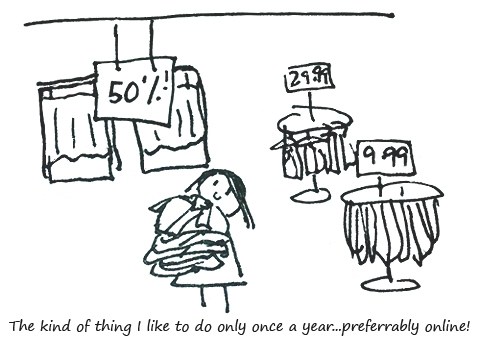To me, Banana Republic was a upper-mid range clothing store. It’s no Alexander McQueen but it wasn’t Ross either.
Then Banana Republic started sending me 40-50% off email coupons. About weekly.
And now I just can’t conceive of buying Banana Republic products at full price. It cheapened the brand for me.
Discounting can have a positive effect and short term lift in sales. It might encourage new consumers to trial your product too.
But discounting done wrong can permanently devalue your brand, because — the moment consumers know to expect discounts, shopping behaviour changes. (Guilty!)

So what are some important things to keep in mind?
Discount frequently and people will wait for the sale (duh, but what’s “frequent”?)
In one study of soft drinks –
- If you discount 50% of the time or more (6 out of 12 weeks), 28% of subjects will pay only the sale price.
- If you offer a deal only 25% of the time (3 out of 12 weeks), 90% of the consumers are willing to pay more than the sale price.
Offering discounts at random to keep people guessing
If you always offer sales in the last day of the month, or around major holidays, people start predicting discounts. Case in point – I stockpile 12-packs of Coke around major holidays because I know Safeway has the buy two cases get three free around all major holidays and sporting events.
As for the subject of why a single person like me buys that much pop…don’t ask. 🙂
However, I haven’t yet reverse-engineered REI’s 20% coupon mailing schedule , so when there are holes in my thermal fleece sweater like there is right now, I’ll be buying a full price replacement.
Chose how you frame the discount
Using coupons or rebates for price promotion helps maintain the brand image. Consumers are less likely to have a lower internal reference price. Options for varying up the price/promotion mix = good. 🙂
Percentage-off promotions were likely to result in a higher expected post promotion price than cents-off promotions. So expressing the discount in percentage terms (eg. 34% off $1.49 instead of $0.50 off) is a better strategy to maintain the ability to sell the product at a regular price later. Keep in mind though, making the value of the percentage discount too easy to calculate (eg. 50% off $100) negates the advantage of using percentages instead of dollars.
If you’re subscription-based, foot-in-the-door discounting isn’t a bad idea.
Comcast does a splendid job on this. They offered me $29 for high speed internet at an introductory price and then 6 months later – a surprise! Here’s the $99 per month bill instead. Consumers are lazy, and some percentage of them won’t notice that change for a while.
Or take FoundersCard’s Charter membership. A steep discount and perceived value of coming in early to lock in lifetime low price probably got them quite a few signups. I signed up.
Then there are permanent discount stores.
About 90% of all furniture stores and 99% of rug stores are perpetually going out of business. But hey, it must work. They are all still here.
Discounting is a perfectly handy tool, but just realize the expectations you are setting. Short term attempts to make the budgeted numbers might not be worth it, but it seems like a fine option if used wisely to level out the demand curve or to bring new customers in the door.
Last thought – does anyone think discount sites like Groupon / LivingSocial have totally re-set the expectation of what a deal is? I now hardly blink at a 50% discount.


Being bombarded with % off and coupons has become more of a hassle for me than a savings benefit. Yet I still can’t go to Bed Bath & Beyond if I don’t have a $5 off coupon.
JC Penney’s new corporate strategy will be an interesting experiment. They are no longer doing any sales, promotions, or door buster deals. Instead, they say the price you pay is the lowest their company is going to offer. I think it’s cool, but I wonder if it will translate into sales.